A game by Robert Leedom, published in 6502 user notes #13, 1979. Typed in by Dominic Bumbaco so we can play it!
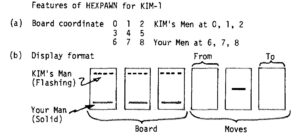
Paper tape and hex dump of the program
Original article
About small SBC systems
A game by Robert Leedom, published in 6502 user notes #13, 1979. Typed in by Dominic Bumbaco so we can play it!

Paper tape and hex dump of the program
Original article

 A Colossal Cave Adventure on a KIM-1? Yes, within the limits of the seven segments LED, and the 1K RAM?
A Colossal Cave Adventure on a KIM-1? Yes, within the limits of the seven segments LED, and the 1K RAM?
The late-70s labor of love by Bob Leedom to create a mini (nano?) version of Colossal Cave Adventure is not lost.
Like Micro-Chess, amazing what can be done with the unexpanded KIM-1!
The original document with (assembled by hand!) source from Bob Leedom has been OCR’ed and converted into loadable tape and papertape files by Dominic Bumbaca and also by Mark Bush.
Dominic also made a recording on Youtube of him playing the game.
Here I present what I have now on this game:
(with thanks to Bob Leedom, Dave Wiliams, Dominic Bumbaca, Mark Bush and Nils)
– PDF with instructions, source code and map (from archive.org)
– Game instructions in PDF
– Papertape files by Dominic Bumbaca
– tape recording by Dominic Bumbaca
– HEX dumps of program Dominic Bumbaca
– Youtube recording by Dominic Bumbaca
– Local copy the Mark Bush Github repository
– Papertape files by Mark Bush
– Intel hex files by Mark Bush
– Assembler sources files by Mark Bush
– Corrected hexpawn100 papertape thanks to Nils
Notes by Mark Bush (see his repository here)
KIM-Venture
KIM-Venture is an adventure game based on Colossal Cave written for the KIM-1. The program and its documentation are Copyright © Robert Leedom and we make no claims to any of this material. I (Mark Bush) have gathered everything together here for posterity.
Installing and Running
Included here are both paper tape and HEX format files. The HEX files can be used on a KIM-1 clone from [Corsham Tech](https://www.corshamtech.com), especially if you have their SD card system.
Load the `Venture-ZeroPage`, `Venture-Game`, and `Venture-Extra` files in any order.
Start the game by going to address `$0100` and pressing `GO`.
When you are finished, load `Venture-Scoring` and run from `$0100` to see how you did.
Note that the scoring program overwrites some page zero locations. If you want to be able to go back to your game after seeing your score, then you will need to save page zero first, then run the scoring program, then load your saved file and also `Venture-Game` again and restart at `$0100`.
The original tape IDs of these files are:
ID | File
—|—–
A1 | Venture-ZeroPage
A2 | Venture-Game
A3 | Venture-Extra
06 | Venture-Scoring
Note for KIM-1 clone users
If you are using the KIM-1 clone, then you will not be able to load the `Venture-Game` or `Venture-Scoring` as HEX files from the SD card system completely because the extended monitor uses the stack. Load them from the paper tape files instead.
Saving a Game
You can save the state of your game by saving a copy of zero page (from `$00` to `$EE`) and making a note of the contents of location `$03BD`.
Return to the game by loading your saved file instead of the original zero page data when you load the program and setting the contents of `$03BD` to the value you noted.
For the full version mentioned below (in an expanded KIM-1), record and restore the contents of `$04BD` instead of `$03BD`.
Instructions
Included here are:
* The Instructions] for playing the game.
* The Game Manual containing information about how to load and run the game
Source Code
The `source` directory contains the original source code for the game with all original comments and formatting preserved. There is one change from the original, though. In `Game.asm` in the Main Move Loop, the original code used absolute addressing for the `INC NMBUTS` statement. [My assembler](https://github.com/markbush/6502-assembler) uses zero page addressing when possible which would make this a 2-byte instruction instead of 3-byte, so I have added a `NOP` to preserve addresses in the output.
The following files contain the source code:
File | Content ----- | --------- ZeroPage.asm | data to be loaded into zero page Light.asm | The LIGHT subroutine which compiles into the start of zero page Game.asm | The actual game which loads into pages 1, 2, and 3 Extra.asm | Some support subroutines which load into the 6530 RAM Scoring.asm | The scoring program
These source files (except `ZeroPage.asm`) are location agnostic.
This allows them to be recompiled into alternate addresses.
The above code can be compiled using the following files:
File | Content
----- |---------
Venture-ZeroPage.asm | Combines LIGHT with the zero page data
Venture-Game.asm | Creates the actual game
Venture-Extra.asm | Creates the file loaded into 6530 RAM
Venture-Scoring.asm | Creates the scoring program
Venture-Full.asm | Creates a combined program for a KIM
with extended memory (or the KIM-1 clone)
These files are necessary as the individual source files refer to locations and subroutines located in the other parts. They can only be assembled together. Each of the above files contains a directive causing only the relevant part to be output, enabling the separate program files to be created.
For the `Venture-Full` version, the game starts at `$0200` instead of `$0100` and avoids using any locations in page 1 (the 6502 stack). You can stop the program to view your score at any time. Press `ST` to stop the program and change to address `$0600` and `GO`. Press `ST` again and rejoin the game from `$0200`.
The `Venture-Full` file does not include the zero page data so that must be loaded separately and will update the location of the message table in POINTR when run. This is partly to avoid trying to load data through stack locations (which could mess up the loading process) and also to make it easier to keep copies of the zero page data in order to save the state of a game.
Saved copies of zero page from the original multi-part program can correctly be used by this full version (because it updates the location of the messages), but if you wish to use a copy of zero page from the full program with the original, then you will need to change the contents of location `$4B` to be `$03` after loading.
**NOTE**: The `Venture-Full` version is a work in progress – try it at your own risk!!
KIM Kenner 18 1981 Hans Otten, Translated by Hans Otten 2021
A program to duplicate a KIM-1 cassette tape with multiple files on it. Command driven. Requires enough memory above $2000 to hold the largest file on tape (32K for example)
Version 1.1 added the Check tape command.
Binary V1.1 can be downloaded here.
Requires two cassette recorders controlled via the Remote control, see below for the Micro Ade description of control via KIM PIA PB2 and PB3.
Source in Micro Ade format, , also downloadable here.
************************************
TAPE COPYING PROGRAM
;
HJC OTTEN JULY 1981 V1.0
JULY 1982 V1.1
;
BASED ON SUPERDUPE FROM THE FIRST BOOK OF KIM
AND THE MICRO ADE CASSETTE ROUTINES
;
COPY WILL REPRODUCE A TAPE COMPLETELY AUTOMATIC
WHEN READ AND WRITE RECORDERS ARE CONNECTED
WITH THE MOTOR CONTROLS OF MICRO ADE
;
DURING READ OPERATIONS IT IS POSSIBLE TO STOP THE
COPYING BY MAKING PA7 OF PIA 1700 HIGH
REMOVE THIS BIT TESTS IF NOT AVAILABLE
AT O249, 02D6 AND 02E9
OR CHANGE FOR KIM TTY BREAK THE PIA LOCATION TO 1740
AND THE BRANCH FOLLOWING TO BMI
;
INSERT REWINDED READ AND WRITE CASSETTES
AND START AT 0200
;
FIRST THE WRITE CASSETTE IS RUN PAST THE LEADER
THEN A FILE IS READ , IF FOUND THE ID AND STARTADDRESS
ARE DISPLAYED . NEXT THE FILE IS WRITTEN.
IF READY THE DISPLAY LINE LOOKS LIKE
ID= 01 START= $3600 COPY !
THE DATA FROM THE FILE IS STORED IN A BUFFER AT $2000
WHERE ENOUGH RAM MUST BE AVAILABLE
;
THIS PROGRAM CAN EASILY BE MODIFIED TO
A CHECKING AND DIRECTORY OF ALL FILES ON A TAPE
BY REPLACING THE JUMP
02D0 4C 2A 02 JMP CREAD
THAT SKIPS THE WRITING OF A FILE
;
*******************************************************
;
COPY ORG $2000 ;
;
DEFINES :
;
BUFFER * $2300 ;
SYNC * $16 ; SYNCHRONISATION CHARACTER
EOD * $2F ; END OF DATA
EOF * $04 ; END OF FILE
SOD * $2A ; START OF DATA
FF * $0C ; FORM FEED
;
; ZERO PAGE USE
HELPL * $00DD ;
HELPH * $00DE ;
CHKCOP * $00DF ; CHECK OR COPY FLAG
;
RPTRL * $00E0 ; READ POINTER IN BUFFER
RPTRH * $00E1 ;
WPTRL * $00E2 ; WRITE POINTER IN BUFFER
WPTRH * $00E3 ;
STRPTL * $00ED ; POINTER IN PRINT STRING
STRPTH * $00EE ;
CC * $00F1 ; COUNT FIELDS IN WRITE
COUNT * $00F2 ;
CHKSUM * $00F6 ; CHECKSUM
CHKHI * $00F7 ;
GANG * $00F5 ; USED BY WRITE
ID * $00F9 ; ID OF FILE
STADRL * $00FA ; STARTADDRESS OF FILE
STADRH * $00FB ;
STARTA * $00FC ; CONSTANT FOR INDEXED WRITE
TRIB * $00FE ; USED BY WRITE
;
; PIA LOCATIES
;
PAD * $1700 ; BREAKKEY IN BIT 7
PBD * $1702 ; PB2 = READ, PB3 = WRITE MOTOR CONTROL
PBDD * $1703 ;
KPAD * $1740 ; LEDDISPLAY
KPADD * $1741 ;
KPBD * $1742 ; CASSETTE I/O
KPBDD * $1743 ;
TIMERT * $1744 ; TIMER
TIMER * $1747 ;
;
; KIM MONITOR ROUTINES
;
RDBIT * $1A41 ; READ BIT FROM TAPE
RDBTK * $19F3 ; READ BYTE FROM TAPE
RDCHTK * $1A24 ; READ CHARACTER FROM TAPE (2 BYTE)
PACKT * $1A00 ; PACK ASCII TO HEX
CHK * $1F91 ; COMPUTE CHECKSUM IN F6,F7
CHKT * $194C ; COMPUTE CHECKSUM IN 17E7,E8
INIT * $1E8C ; INIT KIM PIA'S
SPACE * $1E9E ; PRINT SPACE ON TTY
OUTCH * $1EA0 ; PRINT ACCU ON TTY
PRTBYT * $1E3B ; PRINT ACCU AS TWO HEX CHARACTERS ON TTY
CRLF * $1E2F ; PRINT CR + LF ON TTY
MNITOR * $1C00 ; KIM MONITOR ENTRY POINT
;
*******************************************************
;
MAIN FLOW OF PROGRAM :
;
PROGRAM COPY
;
INITCOPY
REPEAT
READ FILE TO BUFFER
WRITE BUFFER TO FILE
UNTIL FOREVER
;
END
;
*******************************************************
;
PROCEDURES :
;
START CLD ; PROCEDURE INITCOPY
LDAIM $0C ; INIT CASSETTE MOTOR CONTROL
STA PBDD ;
LDAIM $FF ;
STA PBD ;
LDAIM FF ; CLEARSCREEN
JSR OUTCH ;
LDXIM $FF ;
NEX DEX ;
BNE NEX ;
LDXIM HELLOM ; PRINTSTRING ('TAPE COPY')
LDYIM HELLOM /
JSR PRTSTR ;
LDXIM ANDMSG ;
LDYIM ANDMSG /
JSR PRTSTR ;
LDXIM CHKMSG ;
LDYIM CHKMSG /
JSR PRTSTR ;
LDXIM VRSMSG ;
LDYIM VRSMSG /
JSR PRTSTR ;
JSR CRLF ;
JSR CRLF ;
LDXIM CHKMSG ; PRINT ('CHECK OR COPY)
LDYIM CHKMSG /
JSR PRTSTR ;
LDXIM ONLMSG ;
LDYIM ONLMSG /
JSR PRTSTR ;
LDAIM $00 ; CHKCOP FLAG = COPY
STA CHKCOP ;
JSR GETCH ; WAIT FOR ANSWER
PHA ;
JSR OUTCH ; ECHO CHARACTER
JSR CRLF ;
PLA ;
CMPIM 'Y ;
BNE NOCHK ; IF CHAR <> Y THEN COPY
LDAIM $FF ;
STA CHKCOP ;
LDXIM CHKMSG ; PRINT CHECK
LDYIM CHKMSG /
JSR PRTSTR ;
JMP CREAD ;
NOCHK LDXIM COPYMS ;
LDYIM COPYMS /
JSR PRTSTR ; PRINT COPY
LDAIM $F7 ; TURN WRITE CASSETTE MOTOR ON
STA PBD ;
LDXIM $10 ; DELAY (LEADERCASSETTE)
JSR DELAY ;
LDAIM $FF ; TURN WRITE CASSETTE MOTOR OFF
STA PBD ; END INITCOPY
CREAD LDAIM BUFFER / PROCEDURE READ FILE TO BUFFER
STA RPTRH ; READPTR := BUFFERSTART
STA WPTRH ; WRITEPTR := BUFFERSTART
LDAIM $00 ; CHECKSUM := 0
STA CHKSUM ;
STA CHKHI ;
LDAIM BUFFER ;
STA RPTRL ;
STA WPTRL ;
LDAIM $FB ; TURN READ CASSETTEMOTOR ON
STA PBD ;
LDAIM $13 ; INIT CASSETTE I/O
STA KPBD ;
LDAIM $7F ; INIT LEDDISPLAY
STA KPADD ;
SYN BIT PAD ; REPEAT
BPL GOON ; WHILE NOT BYTE = SYNC DO
JMP MONRET ; READ(BYTE)
GOON JSR RDBIT ; IF BREAK EXIT TO MONITOR
LSR ID ; ENDWHILE
ORA ID ; READ(BYTE)
STA ID ; UNTIL BYTE = START OF DATA
STA KPAD ;
TST CMPIM $16 ;
BNE SYN ;
JSR RDCHT ;
STA KPAD ;
CMPIM $2A ;
BNE TST ;
JSR RDBYT ;
STA ID ; ID := READ(BYTE)
LDXIM $FE ; STARTADDRESS := READ(ADDRESS)
ADDR JSR RDBYT ;
STAZX STARTA ;
JSR CHK ;
INX ;
BMI ADDR ;
;
BYTE LDXIM $02 ; WHILE NOT BYTE = END OF DATA DO
DUBL JSR RDCHT ; BUFFER(RPOINTER) := READ(CHARACTER)
CMPIM EOD ; CHECKSUM := CHECKSUM + CHARACTER
BEQ WIND ; RPOINTER := RPOINTER + 1
JSR PACKT ; ENDWHILE
BNE ELNK ;
DEX ;
BNE DUBL ;
STAIX RPTRL ;
JSR CHK ;
INC RPTRL ;
BNE OVER ;
INC RPTRH ;
OVER BNE BYTE ;
WIND JSR RDBYT ; RCHECKSUM := READ(CHECKSUM)
CMP CHKHI ;
BNE ELNK ;
JSR RDBYT ;
CMP CHKSUM ;
PHP ;
LDAIM $FF ; TURN READ CASSETTE MOTOR OFF
STA PBD ;
PLP ; IF RCHECKSUM <> CHECKSUM GREAD FILE TO BUFFER
BNE ELNK ;
JSR CRLF ; PRINTSTRING ('ID=')
LDXIM IDMES ; PRINT (ID)
LDYIM IDMES /
JSR PRTSTR ;
LDA ID ;
JSR PRTBYT ;
LDXIM STMES ; PRINTSTRING (' START=')
LDYIM STMES /
JSR PRTSTR ; PRINT (STARTADDRESS)
LDA STADRH ;
JSR PRTBYT ;
LDA STADRL ;
JSR PRTBYT ;
LDXIM ENMSG ; PRINT ('END = ')
LDYIM ENMSG /
JSR PRTSTR ;
SEC ;
LDA RPTRL ; HELP := READPOINTER - BEGINBUFFER
SBCIM BUFFER ;
STA HELPL ;
LDA RPTRH ;
SBCIM BUFFER /
STA HELPH ;
CLC ; HELP := HELP + STARTADDRESS
LDA HELPL ;
ADC STADRL ;
STA HELPL ;
LDA HELPH ;
ADC STADRH ;
JSR PRTBYT ;
LDA HELPL ;
JSR PRTBYT ;
LDA CHKCOP ;
BNE ELNK ; IF CHECKCOPY FLAG <> THEN CHECK ONLY
JMP CWRITE ;
ELNK JMP CREAD ; END READ FILE TO BUFFER
;
; SUBROUTINE READBYTE
;
RDBYT BIT PAD ; PROCEDURE READ(BYTE)
BMI MONRET ; IF BREAKKEY THEN EXIT TO MONITOR
;
JMP RDBTK ; ENDIF
MONRET LDAIM $FF ; READ BYTE FROM CASSETTE
STA PBD ; END READ BYTE
JSR INIT ;
JMP MNITOR ;
RDCHT BIT PAD ; PROCEDURE READ(CHARACTER)
BMI MONRET ; IF BREAKKEY THEN EXIT TO MONITOR
JMP RDCHTK ; READ CHARACTER FROM TAPE
CWRITE LDAIM $F7 ; PROCEDURE WRITE BUFFER TO FILE
STA PBD ; TURN WRITE CASSETTE MOTOR ON
LDXIM $08 ;
JSR DELAY ; DELAY (FILEGAP)
LDAIM $27 ; INIT WRITE CASSETTE I/O
STA GANG ;
LDAIM $BF ;
STA KPBDD ;
LDXIM $FF ; COUNT := 255
LDAIM SYNC ; WHILE COUNT > 0 DO
JSR NWRITE ; WRITE(SYNCHRONIZATION CHARACTER)
LDAIM SOD ; COUNT := COUNT - 1
JSR OUTCHT ; ENDWHILE
LDA ID ; WRITE (START OF DATA )
JSR OUTBT ; WRITE (ID)
LDA STADRL ; WRITE (STARTADDRESS)
JSR OUTBT ;
LDA STADRH ;
JSR OUTBT ;
DATA LDYIM $00 ; WHILE WPOINTER < RPOINTER DO
LDAIY WPTRL ; WRITE (BUFFER(WPOINTER)0)
JSR OUTBT ; WPOINTER := WPOINTER + 1
INC WPTRL ; ENDWHILE
BNE SAMP ;
INC WPTRH ;
SAMP LDA WPTRL ;
CMP RPTRL ;
LDA WPTRH ;
SBC RPTRH ;
BCC DATA ;
LDAIM EOD ; WRITE (END OF DATA )
JSR OUTCHT ;
LDA CHKHI ; WRITE (CHECKSUM)
JSR OUTBT ;
LDA CHKSUM ;
JSR OUTBT ;
LDXIM $02 ;
LDAIM $04 ; WRITE (END OF FILE)
JSR NWRITE ;
LDAIM $FF ; TURN WRITE CASSETTE MOTOR OFF
STA PBD ;
JSR INIT ;
LDXIM COPYMS ; PRINT ('COPY !')
LDYIM COPYMS /
JSR PRTSTR ;
LDAIM '! ;
JSR OUTCH ;
JMP CREAD ; END WRITE BUFFER TO FILE
;
; SUBROUTINE NWRITE
;
NWRITE STX CC ; PROCEDURE NWRITE (N,CHARACTER)
HICA PHA ; WHILE N > 0 DO
JSR OUTCHT ; WRITE (CHARACTER)
PLA ; N := N - 1
DEC CC ; ENDWHILE
BNE HICA ; END NWRITE
RTS ;
;
; SUBROUTINE OUTBTC
;
OUTBTC JSR CHKT ; PROCEDURE WRITE(BYTE) AS TWO ASCII
OUTBT PHA ;
LSRA ; CHECKSUM := CHECKSUM + BYTE
LSRA ; CONVERT LEFT NIBBLE OF BYTE TO ASCII
LSRA ; WRITE(ASCII)
LSRA ; CONVERT RIGHT NIBBLE OF BYTE TO ASCII
JSR HEXT ; WRITE(ASCII)
PLA ; END WRITE BYTE
HEXT ANDIM $0F ;
CMPIM $0A ;
CLC ;
BMI HEXAT ;
ADCIM $07 ;
HEXAT ADCIM $30 ;
OUTCHT LDYIM $08 ; PROCEDURE WRITE (BYTE)
STY COUNT ; COUNT :=8
TRY LDYIM $02 ; WHILE COUNT > 0 DO
STY TRIB ; SEND 3 PULSES 3700 HZ
ZON LDXAY NPUL ; IF MSB BYTE = 1 THEN
PHA ; SEND 3 PULSES 3700 HZ
ZONA BIT TIMER ; ELSE
BPL ZONA ; SEND 2 PULSES 2400 HZ
LDAAY TIMG ;
STA TIMERT ; ENDIF
LDA GANG ; SEND 2 PULSES 2400 HZ
EORIM $80 ; SHIFT BYTE LEFT
STA KPBD ; ENDWHILE
STA GANG ; END WRITE BYTE
DEX ;
BNE ZONA ;
PLA ;
DEC TRIB ;
BEQ SETZ ;
BMI ROUT ;
LSRA ;
BCC ZON ;
SETZ LDYIM $00 ;
BEQ ZON ;
ROUT DEC COUNT ;
BNE TRY ;
RTS ;
;
; TIMING TABLE
;
NPUL = $02 ; NUMBER OF 2400 HZ PULSES
TIMG = $C3 ; TIMER COUNT
= $03 ; NUMBER OF 3700 PULSES
= $7E ; TIMER COUNT
;
; DELAY ROUTINE
;
DELAY LDYIM $FF ; PROCEDURE DELAY (NR)
YLOOP LDAIM $FF ; DELAY TIME * NR
ALOOP SEC ; END DELAY
SBCIM $01 ;
BNE ALOOP ;
DEY ;
BNE YLOOP ;
DEX ;
BNE DELAY ;
RTS ;
;
; SUBROUTINE PRINT STRING
;
PRTSTR STX STRPTL ; PROCEDURE PRINTSTRING(STRINGPTR)
STY STRPTH ;
PNEXT LDYIM $00 ; WHILE NOT END OF STRING DO
LDAIY STRPTL ; PRINT (MEMORY(STRINGPTR)
PHA ; STRINGPTR := STRINGPTR + 1
JSR OUTCH ; ENDWHILE
PLA ;
BMI LAST ;
INC STRPTL ;
BNE NEXTS ;
INC STRPTH ;
NEXTS JMP PNEXT ;
LAST RTS ;
;
; SUBROUTINE GET CHARACTER
;
GETCH BIT PAD ; PROCEDURE GETCHARACTER ( CHAR )
BPL GETCH ; WAIT FOR STROBE
GWAIT BIT PAD ; WAIT FOR END OF STROBE
BMI GWAIT ;
LDA PAD ; GET CHARACTER
RTS ; END GETCHARACTER
;
; STRING DATA
;
IDMES = 'I
= 'D
= '=
= $A0
;
STMES = '
= 'S
= 'T
= '=
= $A0
;
ENMSG = '
= 'E
= 'N
= '=
= $A0
;
HELLOM = 'T
= 'A
= 'P
= 'E
COPYMS = '
= 'C
= 'O
= 'P
= 'Y
= $A0
;
;
CHKMSG = 'C
= 'H
= 'E
= 'C
= 'K
= $A0
ONLMSG = 'O
= 'N
= 'L
= 'Y
= '
= '?
= $A0
VRSMSG = 'V
= '1
= '.
= '1
= $A0
;
ANDMSG = 'A
= 'N
= 'D ;
= $A0
Original articles KIM Kenner 13 1980, 6502 Kenner 19 1981: Hans Otten PGJ de Beer Trasnlated Hans Otten 2021
In two articles a routine to send a character via serial to a printer (or any serial device) and interface this routine to Micro Ade.
The second version allows for handshake signal CTS.
Baudrate may vary from 300 to 9600 baud. Only one or two (handshake) PIA bits are nevcessary, the serial signal is composed with bit banging.
A simple hardware connection to RS232 in two variants: RS232C signal level compliant or a very simple resistor (sufficient for short distances and most printers).
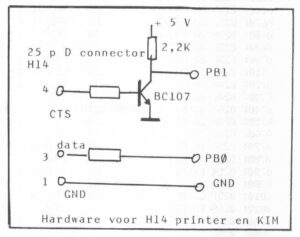
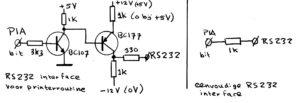
Source in Micro Ade format.
First source with choice of baudrate, second fixed baudrate 4800 baud and CTS handshake.
Also a routine to read a character form a parallel keyboard connected to PIA A with strobe bit in bit 7.
KIM Kenner 19 Patches op Basic Hans Otten, translated by Hans Otten, 20211
May 1981 Byte Magzine had an article in System Notes, Faster Basic for Ohio Scientific.
The article described how the first batch of the 6502 had a faulty ROR instruction, so the programmers of Microsoft Basic had to work around this missing instruction with a slower replacement, (Note 2021: this is well explained in the Pagetable MS Basic articles) and how to patch this to really use the ROR instruction and speed up things.
A letter to the editor in a later Byte (September 1981?) showed the patches required for the KB9 KIM-1 version.
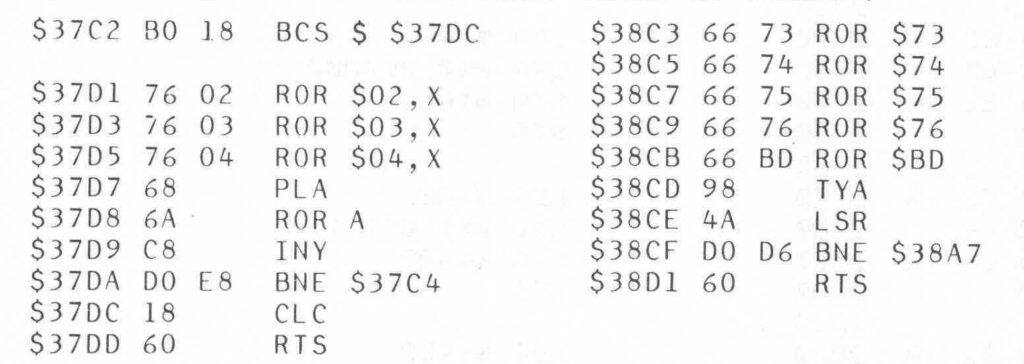
Location $37DE to $3801 and $38D2 to $3903 are now unused.
This patch may speed up KB9 quite a bit for number crunching.
KIM Kenner 10 March 1980, Dutch article by Hans Otten, English translation Hans Otten, 2021
Having an indication of how the reading and writing to the cassette recorder is going is nice. With the Micro Ade routines the LED display is used for this. the standard KIM-1 routines are mute.
This small hardware circuit gives either a visual or audible indication with the standard KIM-1 routines.
How does it work?
An indication for for the read process is the output signal of the PLL circuit, a stream of digital pulsed delivered at PB7 of the RRIOT 6530-002. During the reading pin PB7 is rpogrammed as input, during the wirte it is an output. Via a buffer the output signal signal is brought to Audio-Out and Audio-Out-High.
The use of PB7 as input and output during the read and write process means that during a read the decoded signal appears on Audio Out, and as it is meant to be, during writing also has the output signal. Collision is prevented by blocking the input signal during writing. So this means that during reading and during write the signal is present on Audio-Out. This enables a indication of both read and write processes.
The signal on Audio-Out (application connector A-M) is brought to a transistor (general purpose type) and the alternating signal makes the LED blink quite fast. A miniature loudspeaker can be switched in and the signal can be heard, it is in the hearable audio range. The LED is not very informative, the loudspeaker is, but also can be annoying, so the switch is welcome.
Do not use a lower value than 33 ohm for R2, it will damage the transistor. The circuit does not represent a heavy load, so you can use the KIM-1 power supply.
Construction
A piece of stripboard is sufficient. See the figure below for the connections of transistor and LED. Red, green, yellow can all be used.
Other usage
By programming the output PB7 music or signals can be heard.
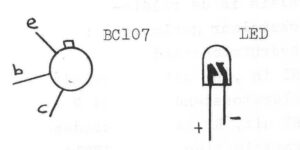
KIM kenner 6 1978 Hans Otten Dutch, translation to English Hans Otten 2021
Reading tapes recorded on another KIM-1 or bought like Tiny basic, Microsoft KB-9, Miccrochess and Micro Ade was not that easy. Many many errors, especially the hypertape format.
Reading and writing of my own tapes, after having configured the PLL following the guide in the User manual, and keeping the cassette recorder clean, now is flawless. With the motor control (see Micro Ade manual appendix) it is a pleasure!
I read and tried all advices, like adjusting the azimuth of the recorder head, cleaning etc. Maybe the variations in tape speed between recorder and my player and the resulting frequency shift was a problem?
What really helped was looking with an oscilloscope at the output of the PLL (pin 7 of the LM311) we can see clearly the problem:
No real problems with noise or dropouts, just deviations between different recordings, so the PLL does not operate correctly. Bought tapes showed the pictures Wrong 1 and Wrong 2. And that leads to reading problems, the software makes the wrong decisions on ‘0’s or ‘1’s.
The following procedure was developed to read the bought tape, store it and save the program on my own tapes:
This helped me to read the problem tapes. Only for Microsoft Basic I had to play with the output volume, large variations in the recorded signal. But it worked in the end and now I have my own recordings on tape, several stored and working copies. One can never have enough backups!
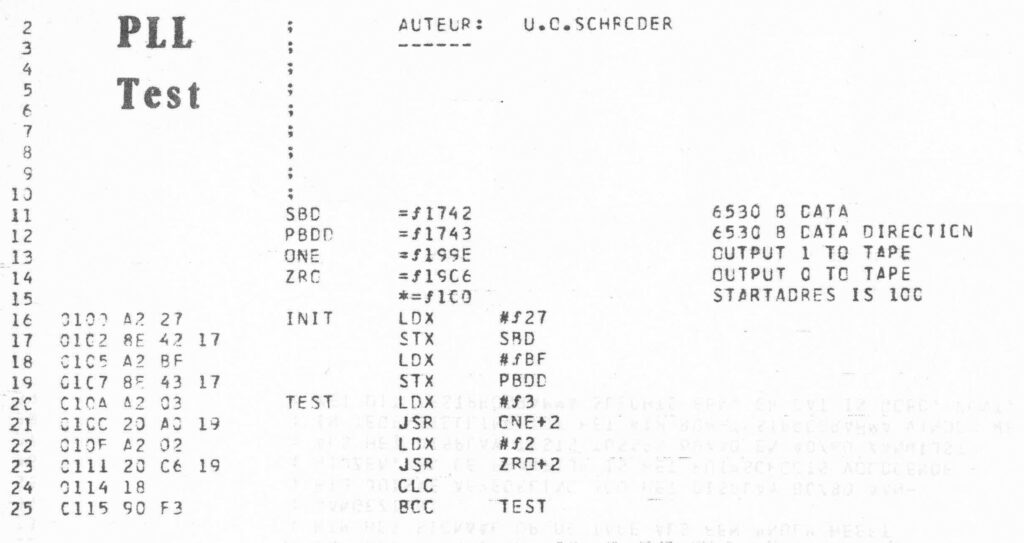
This program write alternate two low frequency or three high frequency tones to the tape recorder.
Record this for a couple of minutes.
When reading this tape the PLL should convert this to a symmetric block pulse.
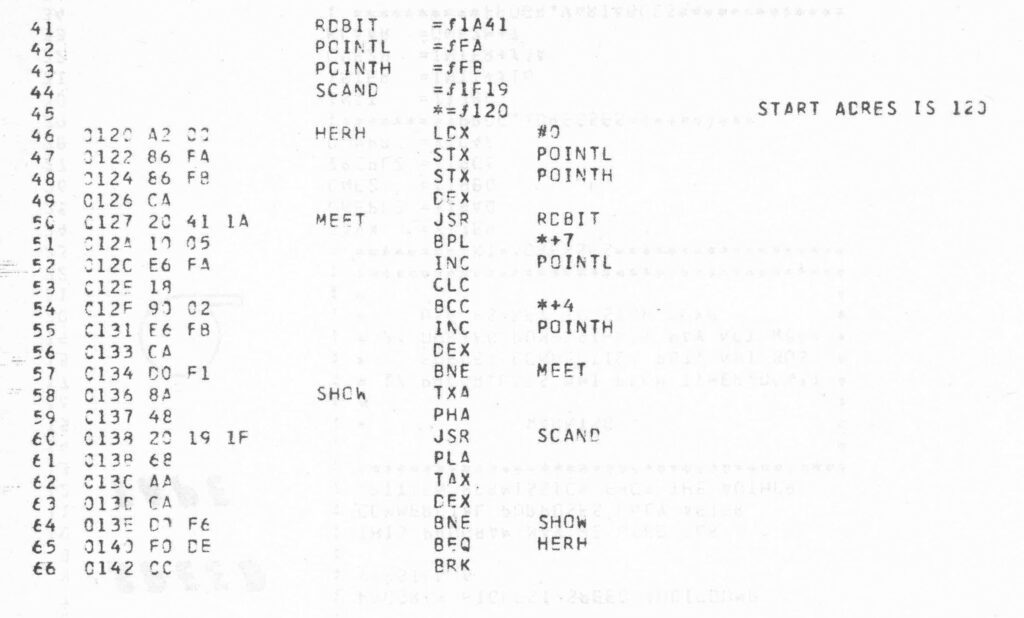
This program shows on the first two digits on the KIM-1 LED display the number of ‘1’s read, on the second two digits the number of ‘0’s read.
When all is well this should 80/80 but anything between 60/A0 and A0/60 is fine.
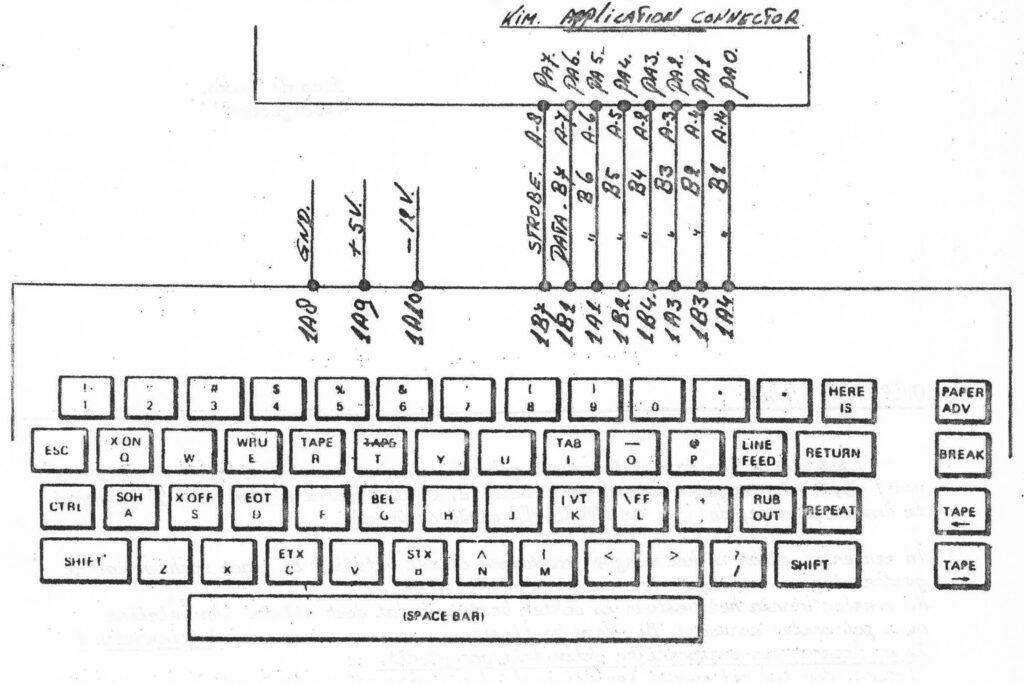 Kenner 2 page 4 July 1977 Co Filmer, translated to english Hans Otten, 2021
Kenner 2 page 4 July 1977 Co Filmer, translated to english Hans Otten, 2021
A parallel ASCII keyboard is a nice addition to the KIM-1.
Connect to the PIA A of the KIM-1 on the Application connector.
Some keyboards may require a -12 V power supply.
The address 1700 now shows the ASCII keyboard code of (the last) key pressed. The high bit (PB7) is the strobe signal, the other 7 bits the ASCII code.
A program should poll the strobe bit, if activated wait for the strobe bit to be deactivated, and then read the key and return.
Testing for keypressed such as a break test means checking the strobe bit, if activated stop processing, etc..
Code fragments by Hans Otten
PAD * $1700 ; BREAKKEY IN BIT 7 ; SUBROUTINE GET CHARACTER ; GETCH BIT PAD ; PROCEDURE GETCHARACTER ( CHAR ) BPL GETCH ; WAIT FOR STROBE GWAIT BIT PAD ; WAIT FOR END OF STROBE BMI GWAIT ; LDA PAD ; GET CHARACTER RTS ; END GETCHARACTER ; ; example of break test ; SYN BIT PAD ; REPEAT BPL GOON ; WHILE NOT keypressed JMP MONRET ; GOON continue processing
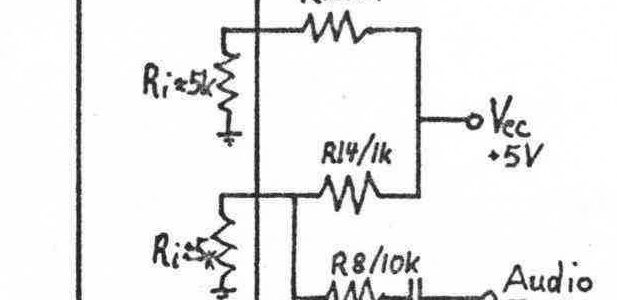
Another article from the Dutch KIM Kenner magazine: